John Hurrell – 23 April, 2012
The fittings that encase HUT's green tipped tubes are split lengthwise between grey backing casing and transparent glass front, so you are aware of inner and outer sides, how each dazzling vector is abruptly blocked by its grey shield as you move around into the inside, and how each slashing line is divided up into modular units. The bright slivers diminish in thickness as you circumnavigate the skeletal structure.
For this Crockford show Bill Culbert is drawing a static configuration in real - not illusory - space, using exterior fluorescent lights to delineate the elemental contours of a rudimentary shed (HUT Made in Christchurch, 2012), and letting you enjoy the piercing intensity of white tubular rods glowing unsubdued by natural daylight. By having the gallery windows uncovered the illumination out of and onto the ‘building’s‘ edges can be savoured, and the strength of the encountered bright light appreciated - in contrast to the bright meteorological conditions observed outside.
The fittings that encase HUT‘s green tipped tubes are split lengthwise between grey backing casing and transparent glass front, so you are aware of inner and outer sides, how each dazzling vector is abruptly blocked by its grey shield as you move around into the inside - the bright slivers diminish in thickness as you circumnavigate the skeletal structure. Each slashing line is divided up into modular units, so the legs look robotic as if the construction can walk.
It is amusing that Culbert has made a wall-less ‘stick-drawing’ dwelling from light, for normally shelters like huts have dark interiors, and keep natural light (at least) out. Usually his Crockford shows have light works clinging to the walls or floor - so a large freestanding sculpture that you can walk through is unusual.
The seven photographs on the wall, from the nineties and eighties, mounted on linen and unframed, are well known. One (Décharge, Sault, 1985), showing a rubbish tip, is photographed from high up, looking down into a deep detritus covered gully. The far hillside is peppered with items that accentuate its shape, and looking towards it as an image is a nice companion to the real depth of the sculpture.
One pair of photographs (Lampdown, 1995) explores planar extensions using glowing bulbs with circular reflecting lampshades. The substance of the plane is suggested by scattered internal saucer-marks, not linear edges as in the hut. The result is an effective foil contrasting the documentation of some earlier artworks (presented as works in their own right) and a directly unmediated experience in the gallery.
John Hurrell
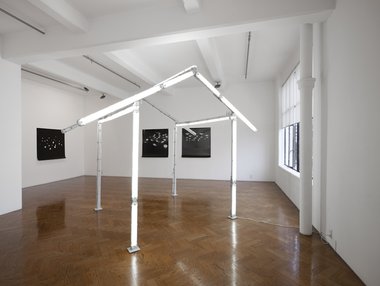

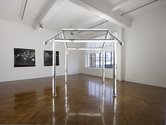
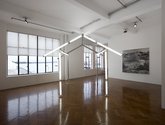
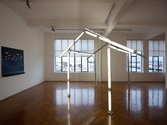
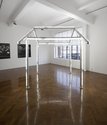
 Two Rooms presents a program of residencies and projects
Two Rooms presents a program of residencies and projects Advertising in this column
Advertising in this column



This Discussion has 0 comments.
Comment
Participate
Register to Participate.
Sign in
Sign in to an existing account.